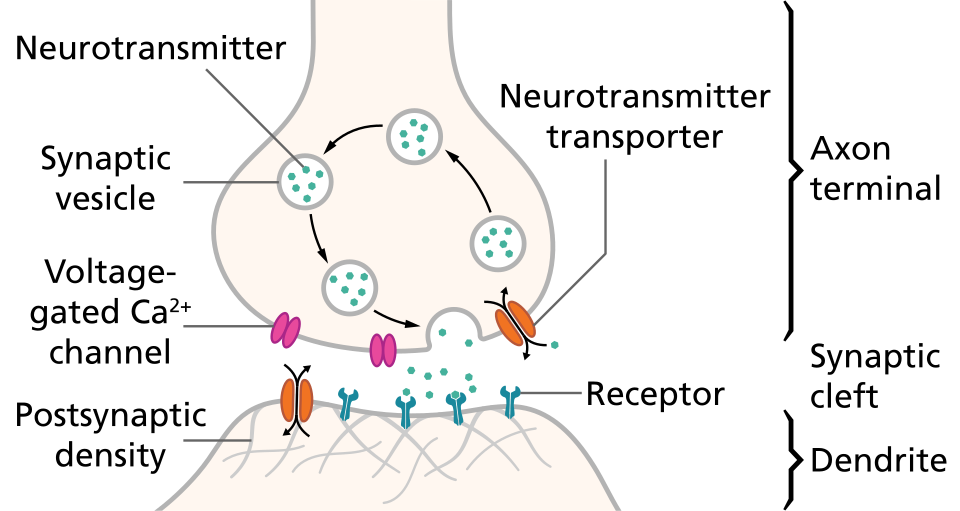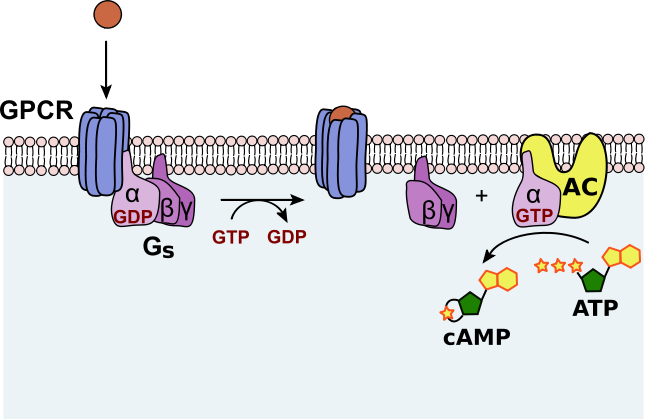OCR Specification focus:
‘Cells communicate by signalling; signals can act between adjacent cells or travel to distant target cells to coordinate responses.’
Communication between cells is fundamental for maintaining coordination, growth, and homeostasis in multicellular organisms. Cell signalling enables cells to detect, process, and respond to internal and external environmental cues efficiently.
1. Overview of Cell Signalling
Cell signalling is the process by which cells communicate to regulate physiological and biochemical activities. It allows coordination between different tissues and organs, ensuring that responses to stimuli are appropriate and balanced.
Cell signalling: The mechanism by which cells detect and respond to specific chemical or electrical signals to coordinate their activities.
Cell signalling involves a signal, a receptor, and a response. The signal is usually a chemical messenger, such as a hormone, neurotransmitter, or cytokine, that binds to a receptor on or inside the target cell.
Key Principles of Cell Signalling
Specificity – Only target cells with the correct receptors can respond to a signal.
Reversibility – Signalling is temporary; responses end when the signal is removed or degraded.
Amplification – One signal molecule can trigger a cascade, leading to a large cellular response.
Integration – Cells often receive multiple signals simultaneously, and the combined effects determine the outcome.
2. Types of Cell Signalling
There are several modes of signalling, differing in the distance over which the signal acts and the nature of the signal molecule.
2.1 Direct (Juxtacrine) Signalling
In juxtacrine signalling, adjacent cells communicate through direct physical contact.
Occurs via gap junctions in animals or plasmodesmata in plants.
Important in embryonic development, where contact between membrane-bound proteins coordinates cell differentiation.
Enables rapid and local coordination between cells.
2.2 Paracrine Signalling
Paracrine signalling involves a local mediator acting on nearby cells within a tissue.
The signal diffuses through extracellular fluid but acts only over short distances.
Common examples include neurotransmitters in synaptic transmission and growth factors that stimulate nearby cell division.
Useful for coordinating activity within tissues, such as during wound healing or inflammation.
2.3 Endocrine Signalling
Endocrine signalling involves hormones secreted into the bloodstream, travelling long distances to reach target organs.
Examples include insulin, adrenaline, and thyroxine.
Endocrine signalling ensures systemic coordination — for instance, regulating blood glucose or body temperature.
2.4 Autocrine Signalling
In autocrine signalling, a cell releases a chemical that binds to receptors on its own surface.
Common in immune responses, where activated T-cells secrete interleukin-2 (IL-2), promoting their own proliferation.
Plays a role in cancer biology, as some tumour cells use autocrine loops to drive uncontrolled growth.
2.5 Synaptic Signalling
Synaptic signalling occurs between neurones and target cells across synapses.

Labeled schematic of a chemical synapse, showing vesicle fusion, neurotransmitter release, diffusion across the synaptic cleft, and binding to ligand-gated receptors on the postsynaptic membrane. This visual reinforces short-distance, rapid, and specific signalling. Minor ultrastructural labels appear but remain fully consistent with OCR expectations. Source.
Neurotransmitters such as acetylcholine or dopamine diffuse across the narrow synaptic cleft.
Transmission is rapid, specific, and unidirectional.
3. Components of Cell Signalling
3.1 Signalling Molecules
Signalling molecules, or ligands, can be classified by their chemical nature and solubility.
Hydrophilic signals (e.g. peptide hormones, neurotransmitters) cannot cross the plasma membrane and bind to cell-surface receptors.
Hydrophobic signals (e.g. steroid hormones, thyroxine) pass through the membrane and bind to intracellular receptors in the cytoplasm or nucleus.
3.2 Receptors
Receptors are proteins that detect specific ligands and initiate intracellular responses.
Receptor: A specific protein molecule that binds a complementary signalling molecule, triggering a cellular response.
Types of Receptors
Ion channel-linked receptors – Ligand binding opens or closes ion channels (e.g. acetylcholine receptors in muscle).
G protein-coupled receptors (GPCRs) – Binding activates G proteins, which influence enzymes such as adenylyl cyclase, leading to cyclic AMP (cAMP) formation.

Schematic of a GPCR (Gs) activating adenylyl cyclase (AC), which catalyses ATP → cAMP. cAMP then activates intracellular effectors (for example protein kinase A) to amplify the response. The diagram slightly exceeds OCR breadth by hinting at the Gα subunit detail, but this supports conceptual understanding without adding clutter. Source.
Enzyme-linked receptors – Often have intrinsic enzyme activity, such as tyrosine kinase receptors that phosphorylate proteins to propagate signals.
Intracellular receptors – Found in the cytoplasm or nucleus; ligand binding forms a receptor–ligand complex that regulates gene expression.
4. Signal Transduction Pathways
Signal transduction refers to the cascade of intracellular events triggered by receptor activation. These pathways convert an external signal into a specific intracellular response.
4.1 The Role of Second Messengers
Second messengers are small molecules that relay signals within the cell. Examples include:
cAMP (cyclic adenosine monophosphate) – Activates protein kinase A, influencing metabolic pathways.
Ca²⁺ ions – Control muscle contraction, secretion, and enzyme activation.
Inositol triphosphate (IP₃) – Promotes release of Ca²⁺ from intracellular stores.
EQUATION
—-----------------------------------------------------------------
Adenylyl Cyclase Reaction (AC): ATP → cAMP + PPᵢ
ATP = Adenosine triphosphate, energy-carrying molecule (unit: mol)
cAMP = Cyclic adenosine monophosphate, a second messenger
PPᵢ = Inorganic pyrophosphate, by-product
—-----------------------------------------------------------------
Each signal cascade can amplify the original stimulus, ensuring that even small extracellular signals produce large cellular effects.
4.2 Phosphorylation Cascades
Many signalling pathways involve kinase enzymes, which transfer phosphate groups to target proteins.
Phosphorylation changes the shape and activity of proteins, activating or deactivating enzymes.
Protein kinase cascades allow fine control and signal amplification.
4.3 Signal Termination
Signalling is carefully regulated and terminated to prevent overstimulation.
Enzymatic degradation of signalling molecules (e.g. breakdown of cAMP by phosphodiesterase).
Receptor desensitisation or internalisation after prolonged exposure.
Negative feedback loops to reduce sensitivity once homeostasis is restored.
5. The Importance of Cell Signalling in Organismal Coordination
Cell signalling enables the integration of physiological systems and maintenance of homeostasis. For example:
Neuronal signalling coordinates rapid responses to environmental stimuli.
Hormonal signalling maintains longer-term control of growth and metabolism.
Immune signalling ensures coordinated defence mechanisms.
Plant signalling through hormones like auxins and gibberellins directs growth responses to environmental changes.
Effective communication between cells underpins processes from embryonic development to immune defence, ensuring that multicellular organisms respond coherently to changing internal and external conditions.
FAQ
Chemical signalling allows communication across a much wider range of distances than electrical signalling.
It enables coordination between non-excitable cells, such as endocrine or immune cells, that cannot transmit action potentials.
Chemical messengers can circulate in the bloodstream, reaching distant targets.
Signals can be amplified, allowing one hormone molecule to trigger thousands of intracellular reactions.
The response is often slower but longer lasting, ideal for maintaining homeostasis rather than rapid reflexes.
Specificity is achieved through the unique three-dimensional structure of receptors. Only target cells express receptors that are complementary to the signalling molecule’s shape and charge.
Additional mechanisms include:
Receptor localisation, where receptors are present only on particular cell types.
Signal degradation or removal, ensuring the signal does not reach unintended cells.
Intracellular signalling proteins that only exist in specific target cells, allowing tailored responses even to the same ligand.
Signal amplification allows a small number of extracellular signal molecules to produce a large intracellular response, ensuring sensitivity and efficiency.
For example:
One hormone binding to a receptor can activate multiple G proteins, each triggering adenylyl cyclase to produce many cAMP molecules.
Each cAMP molecule can activate protein kinase A, which phosphorylates many target enzymes.
This ensures that even weak stimuli can lead to strong, measurable physiological effects without requiring large amounts of signalling molecules.
Cells use multiple regulatory mechanisms to terminate or dampen signalling once the desired effect is achieved.
These include:
Receptor desensitisation, where receptors become temporarily unresponsive or are internalised.
Enzymatic breakdown of second messengers, such as cAMP degraded by phosphodiesterase.
Feedback inhibition, where downstream products inhibit earlier steps in the pathway.
These controls maintain homeostasis and prevent damage from excessive signalling.
Disruptions in signalling can lead to serious physiological disorders.
Examples include:
Cancer, when faulty receptor tyrosine kinases lead to uncontrolled cell division.
Diabetes, resulting from defective insulin signalling or receptor insensitivity.
Neurological disorders, where abnormal neurotransmitter signalling affects brain communication.
Such conditions often arise from mutations in receptor genes, aberrant signal production, or failure of feedback control, demonstrating how vital accurate signalling is to organismal health.
Practice Questions
Question 1 (2 marks)
Explain the difference between paracrine and endocrine cell signalling.
Mark scheme:
1 mark: Paracrine signalling acts over short distances between nearby cells within the same tissue.
1 mark: Endocrine signalling involves hormones travelling in the bloodstream to act on distant target cells or organs.
Question 2 (5 marks)
Describe the sequence of events that occurs when a signalling molecule binds to a G protein-coupled receptor (GPCR) on a target cell. Include the role of second messengers in your answer.
Mark scheme:
1 mark: Signalling molecule (ligand) binds to the GPCR on the cell surface, causing a conformational change in the receptor.
1 mark: Activated GPCR stimulates an associated G protein by promoting exchange of GDP for GTP on the alpha subunit.
1 mark: The activated G protein alpha subunit dissociates and activates adenylyl cyclase (or another effector enzyme).
1 mark: Adenylyl cyclase converts ATP into the second messenger cyclic AMP (cAMP).
1 mark: cAMP activates protein kinase A (PKA), which phosphorylates target proteins, amplifying and producing the cellular response.

